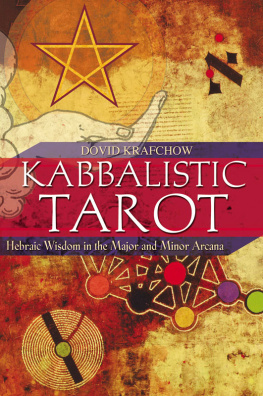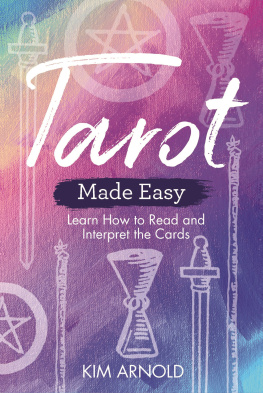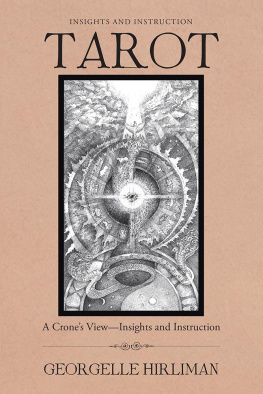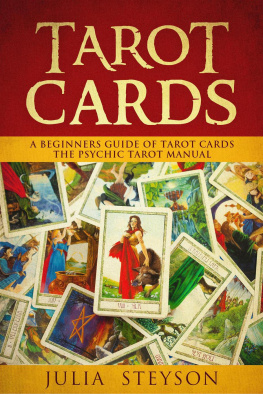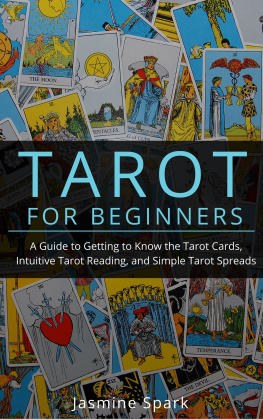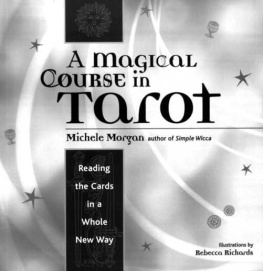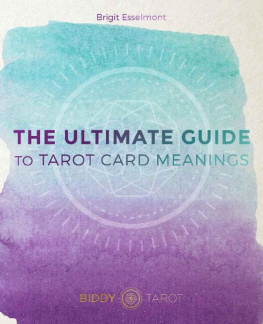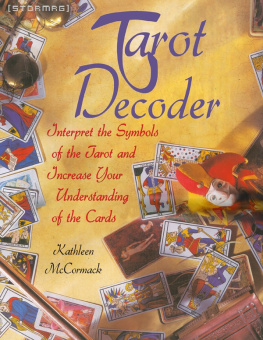KABBALISTIC
TAROT

Hebraic Wisdom in the Major and Minor Arcana
Dovid Krafchow

Inner Traditions
Rochester, Vermont
For my children

ACKNOWLEDGMENTS
Cabala, from whence the tarot was derived, simply means receive. The ancients used the word to indicate a uniquely personal experience that draws new or forgotten knowledge down from the heavens. The wise warned against revealing or teaching ones personal knowledge, fearing a great power could be unwittingly released.
In our time, a time of profound confusion and spiritual weakness, it is incumbent to share our knowledge on as wide a scale as possible. This book is an attempt to share but a few small kernels of wisdom from the Cabala.
I would like to thank my friends Dena and Shawna for their help and their encouragement throughout this project. I would also like to thank Vickie Trihy from Inner Traditions for her thoughtful questions and her exceptional ability to put all of this together in a way in which the reader can receive the teachings. In Talmudic times the teacher often had a meturgeman, one who would take the teachers words and make them palatable to the public. Thank you, Meturgeman.
CONTENTS
PREFACE
Out of Israels 2,000-year exile a principle has emerged: From the deepest darkness comes the greatest light. For that reason, the cabalists say, we see out of the dark spot, the pupil of the eye.
Similarly, I discovered the tarot during the bleakest time of my life. Recently divorced after nineteen years of marriage, living alone without my children, I wandered the streets of New York City looking for something to engage my unwanted and newly secured freedom. My love of books drew me into a used bookstore, where I absently perused the volumes, wandering aimlessly from shelf to shelf without direction or inclination.
I do not know what drew me to that book about the tarot, but the word brought back a flood of memories. One Vermont winter night in the 1960s, my friend Laine had rolled in from California, straight from his little cabin on Happy Trails Road. He was filled to overflowing with his discovery of the tarot cards, and of Haile Selassie, Lion of Judah, Emperor of Ethiopia.
Soon after Laines visit, I adopted a puppy and called her Jude. Jude and I hitchhiked to Maine. There we met a lumberjack who owned a 1952 Pontiac that, he insisted, once belonged to Haile Selassie, Emperor of Ethiopia. Charmed by the coincidence, I stayed and worked for him in exchange for shelter in a dilapidated farmhouse.
But to purchase the emperors ex-car, which could have been mine for a mere $150, I would need to be resourceful. Because of my beard and long hair, employment in the local area was sketchy. So I journeyed to Bangor. By chance I encountered a rabbi who urged me to go to New York City and take up the study of Torah. Abandoning Haile Selassie, I traveled south. For the next two decades I dedicated myself to the study of the four levels of the Torah: the written word, the extrapolated idea, the metaphor, and the secret. For ten of those years I lived in Sfat, Israel, where some of the most influential cabalists lived and taught.
Twenty years after Laines visit, I found myself staring at a large gilded book that promised to reveal The Secret Knowledge of the tarot. One word stood out among all the other terms scattered through that book: Cabala. The author acknowledged that the true meaning of the tarot was locked up in the Cabala, but he had only a vague idea of its underlying principles. Drawings of the tarot cards appeared throughout his book; he identified them as belonging to the Rider-Waite deck.
I figured that if the cards were really cabalistic, I would be able to understand them on my own. Replacing the book on the shelf, I sought out my first tarot deck. What I discovered in that deck, and what I learned from many years of tarot study and practice, is the subject of this book.
The Talmud says that ones fifties are years of advising. Following this tradition, I took my little table and a few folding chairs, and went out on the road to become an itinerant teacher, teaching Torah by means of the tarot and advising the body through the voice of the spirit.

Note to the reader: Although the established convention as put forth by the rabbis has Kabbalah spelled with a Kthe rabbinic kosher stampI prefer Cabala because it is more to the point. The Cabala is the most feminine of the Jewish teachings; even among the esoteric works, Cabala is the ultimate hidden secret. Therefore, in my opinion, Cabala should be written with a curve, denoting the feminine, and not defined by the line of the rabbis. Rigidity, the line, is the antithesis of the subtle, ephemeral truths that swim in the deep waters of the Cabala.
INTRODUCTION
ANCIENT ROOTS OF THE TAROT
The tarot cards are a vehicle of truth. These seventy-eight numbered and illustrated cards are believed to have their roots in the earliest Jewish spiritual tradition. The current cards have been used for over five hundred years, since the time of the Spanish Inquisition and the forced conversions of the Jewish people to Christianity. But the tarots origins far predate modern history. I am convinced that tarot originated as a clandestine means for the captive tribes of Israel to study their sacred texts. The configuration of images and symbols embedded in the cards reflects the ancient esoteric knowledge known as Cabala. By exploring the historic roots and cabalistic elements of the tarot, we can derive the fullest and truest meaning from this ancient instrument.
The pictures on the cards are an outgrowth of the first captivity of the people of Israel in Egypt. There the children of Israel were slaves in a land where written language took the form of pictureshieroglyphics. The experience of living in subjugation in Egypt and the subsequent exodus therefrom fused the twelve tribes into one people. It also indelibly engraved picture language upon the oral traditions and legends of the people.
Israel endured a second captivity a millennium after their liberation from Egypt, this time in Babylon, or Persia. Conquered by Nebuchadnezzar, their Temple destroyed and the people carried off in chains, they lived as strangers in the land of their oppressors. Although they rose to positions of importance in the court of Persia, they remained a people apart. An official by the name of Haman, known as the persecutor of the Jews, hatched a plot to destroy the entire people. Their fate depended upon chancea game, the casting of lots to determine the date of the massacre. But the tables were turned by Esther, the Persian kings Jewish wife, who exposed the plot to her husband; Haman was put to death and the Jewish people were saved. (That miracle, celebrated in the holiday of Purim, which means lottery in the Persian language, is recounted in the book of Esther.) Encouraged by Cyrus the Great, Esthers son and the next king of Persia, the Jews returned to Jerusalem and began to recover their learning and to rebuild their Temple.
A few hundred years later Israel was invaded by Alexander the Great. His conquest had an immense impact on the Jewish people as witnessed by many references and tales in the sacred texts known as the Talmud. In one such tale, Alexander demanded that the rabbis lead him to paradise. The rabbis agreed, but when they reached the gates of paradise, an angel appeared to inform Alexander that he could not enter because he had killed. However, since he was a king, the angel gave Alexander a present, a consolation prize: a small round stone. The angel told him, Nothing can outweigh this stone.
Next page
